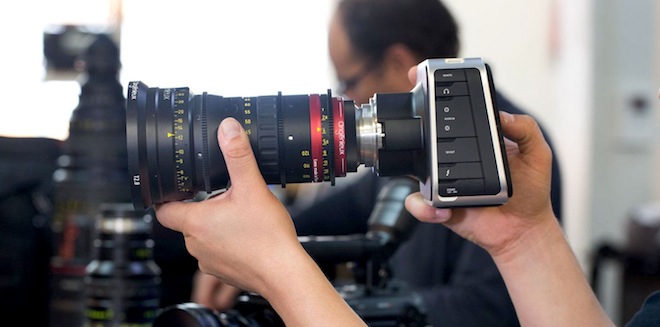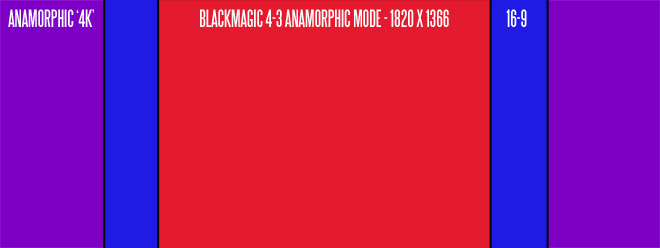
The Blackmagic Cinema Camera is nearing release and final sensor calibration / firmware adjustments are taking place. When I last spoke to beta shooter John Brawley about his involvement with the camera, he had this to say on an anamorphic mode…
“We have discussed the possibility of doing anamorphic. They’re aware that it’s a potential market. I don’t think you’ll see it on this version.”
This feature would increase vertical resolution by nearly 800 lines and allow for the wider, more cinematic aspect ratios of 2.39:1 and 2.66:1 aspect ratios when used with an anamorphic lens.
However – this close to release, feature requests will I expect be restricted to small changes in firmware. Anything more would delay the release! So here’s how to do it a simpler way with a possible firmware update…
First some explanation of the way anamorphic works
2x anamorphic lenses are designed to turn a boxy aspect ratio similar to 4:3 into cinema magic. That is widescreen at 2.39:1 or 2.66:1. None of this 16:9 rubbish – that is for TV!
Now the advantage over simply cropping the top and bottom to create the wide aspect ratio is that you maintain the full capture area of the sensor and the full vertical resolution of the image.
With a sensor like that in the Blackmagic Design Cinema Camera, at 2160 vertically, anamorphic would be a big advantage for resolution. Currently the camera does not use all that resolution, instead it records only 1366 lines vertically in 16:9. A big difference.
Similarly, adding black bars in post to your 16:9 DSLR footage reduces the field of view vertically as well as resolution, it is a bit naff. Cropping is a poor substitute for true Cinemascope anamorphic optics as you don’t get the authentic cinema look of the lens, which in my opinion makes as much if not more of a difference to cinema as 24p does over interlaced 60i. So many aspects of the image are more cinematic, not just the trademark anamorphic flare so loved by J.J. Abrams and Ridley Scott.
So suppose you have your Iscorama, Hawk or Panavision at the ready. Next, there are two ways of handling digital anamorphic footage in post for theatre projection, or simply Vimeo. A squeeze or a stretch. (If you have an anamorphic projection system the lens does it for you).
1. Squeeze
For standard 16:9 displays it is preferable to squeeze the image vertically to 1920 x 540 (if using a 2x anamorphic). To maintain the full resolution of the footage vertically, your display needs to be wider than 1920 pixels horizontally. Most aren’t. This squeeze does however help to create a finer pixel pitch and makes soft DSLR footage like that from the 5D Mark III more detailed looking on a 1920 x 1080 display.
2. Stretch
With a stretch horizontally in post by 2x or 1.5x (depending on the anamorphic lens used) you can maintain the full (or close to) vertical resolution for 4K cinema projection and home theatre projection or indeed any display which goes above 1920 pixels horizontally like the new MacBook Pro retina display, Apple Cinema Display and Dell U2711.
Stretching out 2.5k raw to nearly 4K horizontally and maintaining the full vertical resolution of the image with a lovely 2.66:1 aspect ratio is as close to a Red Epic or Alexa Studio the Blackmagic Cinema Camera can get. It would look *beautiful* on a 4K2K display or 4K projector.
But there’s a problem.
With cameras that shoot in 16:9 like the Blackmagic Design Cinema Camera, the Canon C300, Sony F3, DSLRs and the vast majority of others, an anamorphic with 2x factor produces an image from 16:9 which is extremely wide – 3.55:1
I actually like this look, I find it dramatic. But by no means is it a cinema or projection standard and some might find it just too wide and odd looking.
Also on a 1080p display, your vertical resolution is squashed by half to just 540p.
Now the Blackmagic Cinema Camera has a sensor which is rather square, very close to 4:3 and perfect for anamorphic conversion. But it shoots with an activate area of 2432 x 1366 which is 16:9. The full resolution of the sensor is cropped significantly down from 2560 x 2160. You lose nearly 800 lines of resolution vertically to get to 1366 pixel 16:9. It would be a significant change at such a late stage to have a mode that records in 2560 x 2160 (or rather 2560 x 1920 which is exactly 4:3).
So here’s a solution –
To achieve a 4:3 mode in-camera, Blackmagic can record in a 1820 x 1366 4:3 mode. DSLRs already have a 4:3 mode – the VGA 640×480 setting. It should be a simple firmware setting. All this does is crop the sides.

Above: aspect ratios compared. 4:3 (red) goes nicely to anamorphic (widest, in purple) with a 2x stretch. 16:9 (blue) is very ‘TV’
The field of view isn’t hurt much, since the anamorphic lens widens this optically to compensate. It compresses significantly more of the picture into the less wide sensor area, as opposed to not using an anamorphic attachment in 16:9 mode.
The BMD’s monitor – like the Zacuto EVF – could even do a live squeeze of the image into the proper aspect ratio for monitoring purposes. The camera could output the file either upscaled (stretched horizontally) to close to 4K (3640 x 1366) which would be a massively eye catching spec on the box, pre-squeezed to 1920 x 720 ProRes or simply unaltered as raw 1820 x 1366 for you to apply the appropriate post method for your anamorphic lens.
4:3 goes to a very attractive 2.66:1 with a 2x anamorphic lens, and 2.39:1 with an Iscorama 1.5x anamorphic.
If this is possible in firmware, even without compensating for the distortion of the anamorphic lens on the monitor, please do it Blackmagic Design and I will be your friend forever.
Other EOSHD feature request
These are quite significant so I have these in mind not for now, but for possible consideration on future models.
ISO 50
The minimum ISO is 400 and you’ll need NDs. No question. Only optimal shutter speeds are offered, there’s no cop-out 1/2000 like on a DSLR. So get your matte box out! However I strongly believe that in 2012 ND filters should be a thing of the past and I am quite baffled as to why they’re not yet done electronically by reducing the sensitivity of the sensor. I’d love to see a built in electronic feature which emulates an ND by using super-low ISO sensitivities. I have no idea if this is possible or not with the sensor they’re using.
Low profile BMD external battery
The BMD needs an external battery because the internal one cannot be hot swapped on location and it doesn’t have much in the way of capacity. There will be plenty of great third party offerings here but my suggestion to Blackmagic Design is to work on a very low profile battery grip for those who don’t want to wire up a chunky battery to a rig. This battery could go on the bottom of the camera like a DSLR battery grip or even consist of cells distributed inside a handlebar style grip. Anything to avoid having an external block hanging off the camera via a 12v cable!
Micro Four Thirds lens mount option
EF mount is OK for adapting a variety of lenses (Nikon, PL, Contax Yashica Zeiss and Zeiss ZF are in) and preferable to a Nikon mount. But it rules out a lot of nice Micro Four Thirds glass which would have been perfectly suited to the BMDCC’s sensor – like the Voigtlander Nokton 17.5mm and 25mm F0.95. Also vintage 16mm c-mount stuff is out like the beautiful Kern Switar 26mm F1.1. These super fast aperture lenses would be critical for giving a shallower DOF look on the smaller sensor. Also high quality but very affordable Canon FD lenses cannot be used. At the higher end Leica M mount lenses and the T0.95 cinema lens by SLR Magic cannot be mounted. It also rules out LOMO OCT18 anamorphic shooting. Fast wides are very limited by the EF mount and sensor size combination. Whilst the Tokina 11-16mm F2.8 is a good option, anything faster like the Olympus 12mm F2 or SLR Magic 12mm F1.6 won’t fit.


